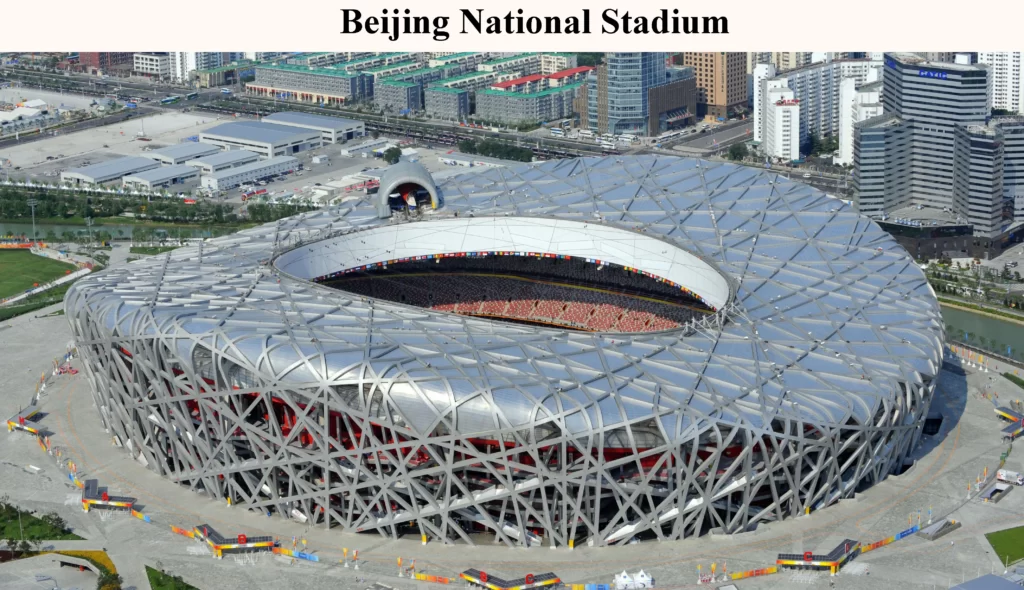If you want to know about the Permeable concrete or Islamic architecture or staircase design, please click the link.
Introduction
Buckminster Fuller was an American architect, inventor, engineer, and futurist, born in 1895 in Massachusetts. He attended Harvard University but was expelled twice due to financial problems. He went on to become one of the most influential figures in architecture and engineering of the 20th century, known for his innovative ideas and designs.

Buckminster Fuller’s importance in the field of architecture stems from his pioneering work in developing new structural systems and sustainable design concepts.
He is known for his geodesic dome design, which revolutionized the building industry and opened up new possibilities for lightweight, efficient, and eco-friendly structures.
Additionally, his application of the principles of synergetics and tensegrity in architecture, as well as his advocacy for sustainability, have had a lasting impact on the field.
1) Life and Career of Buckminster Fuller
Buckminster Fuller was born in Milton, Massachusetts in 1895. He attended Milton Academy but was expelled twice, and later enrolled at Harvard University, where he studied architecture.
After leaving Harvard without graduating, Fuller began his professional career as a construction worker, before starting his own company designing and manufacturing lightweight, prefabricated housing units. He also worked as a teacher, lecturer, and writer, advocating for sustainable and efficient design.
Fuller’s most significant contributions to architecture include the development of geodesic domes, which he first conceived of in the 1940s. The geodesic dome is a lightweight, self-supporting structure made of triangular elements that can be assembled quickly and efficiently. The design has been used in a variety of applications, from housing to sports arenas to space exploration.
In addition to the geodesic dome, Fuller also pioneered the use of tensegrity structures in architecture. Tensegrity structures use tension and compression to create stable, efficient designs, and have been used in everything from sculptures to bridges to buildings.
Fuller’s work in architecture was guided by his interest in synergetics, the study of how systems work together to create emergent properties. He believed that architecture should be based on natural principles, and that efficient and sustainable designs could be achieved by understanding the underlying principles of the universe.
Throughout his career, Fuller received numerous awards and recognition for his contributions to architecture and design. He was awarded 28 U.S. patents and more than 50 honorary degrees, and in 1968 he was awarded the Gold Medal of the American Institute of Architects. He also received the Presidential Medal of Freedom in 1983, shortly before his death.
2) Geodesic Domes
Geodesic domes are a type of lightweight, self-supporting structure composed of a network of interconnected triangles. The structure is based on a mathematical concept known as a geodesic, which is the shortest path between two points on a curved surface.
The concept of geodesic domes has been around for centuries, but Buckminster Fuller is credited with popularizing and refining the design in the 1940s.
Fuller introduced geodesic domes to the world through a series of lectures and demonstrations, starting with his presentation at the annual meeting of the American Institute of Architects in 1949. He went on to develop several prototypes, including the famous Montreal Biosphere, which was built for the 1967 World’s Fair.

The advantages of geodesic domes in architecture include their strength, efficiency, and versatility. Because they are composed of a network of triangles, they distribute weight evenly and are able to withstand high winds and heavy snow loads. They are also lightweight and require minimal materials, making them a cost-effective and eco-friendly option.
Geodesic domes are also versatile in their use, as they can be constructed in a variety of sizes and configurations, and can be adapted for use in a variety of applications, from housing to commercial buildings to greenhouses.
Examples of geodesic domes in architecture include the Montreal Biosphere, which was designed by Fuller and served as the U.S. pavilion at the 1967 World’s Fair. Other notable examples include the Eden Project in the UK, which features several large geodesic domes housing indoor biomes, and the Epcot Center at Walt Disney World, which features a large geodesic dome housing a ride attraction.

3) Synergetics
Synergetics is the study of how systems work together to create emergent properties, and how these systems can be optimized for maximum efficiency and sustainability. Buckminster Fuller was deeply interested in synergetics, and his work in architecture was guided by his understanding of how natural systems work together.
Fuller applied synergetics to architecture by using natural principles and mathematical models to develop efficient and sustainable structures. He believed that by understanding the underlying principles of the universe, architects could design structures that were not only functional and beautiful, but also harmonious with the natural world.
The advantages of synergetics in architecture include their efficiency, sustainability, and beauty. By optimizing the design of a structure to work with natural principles, architects can create buildings that are more energy-efficient, require fewer materials, and have a smaller environmental footprint. Synergetic designs are also often strikingly beautiful, as they are based on natural principles of form and structure.
Examples of synergetics in architecture include the Honeycomb House in South Korea, which was designed by architect Oscar Mendez using synergetic principles to create a lightweight, energy-efficient structure. Another example is the Montreal Biosphere, which was designed by Buckminster Fuller and is based on a geodesic dome structure that incorporates synergetic principles of efficiency and sustainability.

4) Tensegrity Structures
Tensegrity structures are a type of lightweight, self-supporting structure composed of a network of tension and compression elements. The concept of tensegrity was first introduced by Buckminster Fuller in the 1960s.
Fuller introduced tensegrity structures to the world through a series of lectures and demonstrations, and by incorporating them into his architectural designs. He believed that tensegrity structures had the potential to revolutionize the way we design and build structures, by creating lightweight, efficient, and beautiful buildings that could withstand the forces of nature.

The advantages of tensegrity structures in architecture include their strength, efficiency, and versatility. Because they are composed of a network of tension and compression elements, they distribute weight evenly and can withstand high winds and seismic activity. They are also lightweight and require minimal materials, making them a cost-effective and eco-friendly option.
Tensegrity structures are also versatile in their use, as they can be constructed in a variety of sizes and configurations, and can be adapted for use in a variety of applications, from housing to commercial buildings to bridges.
Examples of tensegrity structures in architecture include the Aviary at the San Diego Zoo, which was designed by Buckminster Fuller and features a tensegrity structure composed of steel cables and aluminum tubes.

Another example is the Kurilpa Bridge in Brisbane, Australia, which features a tensegrity structure that spans the Brisbane River and connects the city’s central business district with the South Bank cultural precinct.

5) Sustainability in Architecture
Buckminster Fuller was a visionary in the field of sustainability, and his views on the importance of sustainable design were ahead of his time. He believed that humanity needed to fundamentally rethink its relationship with the natural world, and that architecture had a key role to play in this transformation.
Fuller incorporated sustainability in his architecture by designing structures that were energy-efficient, made use of renewable materials, and were designed to have a minimal impact on the environment. He believed that architecture should be harmonious with the natural world, and that buildings should be designed to work with the forces of nature, rather than against them.
Examples of sustainable architecture designed by Buckminster Fuller include the Dymaxion House, which was designed in the 1920s and featured a lightweight, energy-efficient design that made use of renewable materials. Another example is the Geodesic Dome, which was designed in the 1940s and 1950s and was based on a lightweight, efficient structure that made use of minimal materials.

Another example of sustainable architecture designed by Fuller is the World Game, a vision for a global computer game that would use technology to promote sustainable development and environmental stewardship. The World Game was based on Fuller’s belief in the importance of using technology to create a sustainable future, and it remains a powerful vision for a more sustainable world.
6) Legacy and Influence
Buckminster Fuller’s influence on contemporary architecture is significant, as his ideas and concepts continue to shape the way architects and designers approach their work. His visionary approach to design and his commitment to sustainability have inspired generations of architects and designers to think outside the box and to push the boundaries of what is possible in architecture.
Buckminster Fuller’s ideas and concepts are still relevant today because they address many of the challenges we face in the 21st century, including climate change, resource depletion, and social inequality. His commitment to sustainability and his belief in the power of technology to create a more just and sustainable world are particularly relevant in today’s world, where these issues are more urgent than ever.
Examples of contemporary architecture influenced by Buckminster Fuller include the Eden Project in Cornwall, England, which features a series of geodesic domes that house a diverse collection of plants from around the world. Another example is the Institute of Contemporary Art in Boston, which features a dramatic cantilevered design that was inspired by Buckminster Fuller’s work on tensegrity structures.

The Beijing National Stadium, also known as the “Bird’s Nest,” which was designed for the 2008 Olympic Games, is another example of contemporary architecture influenced by Buckminster Fuller.

The stadium’s iconic structure is based on a lattice of steel beams that resemble the structure of a bird’s nest, and it demonstrates the power of architecture to create memorable and inspiring structures that capture the imagination.
7) Conclusion
In summary, Buckminster Fuller was a visionary architect and inventor who made significant contributions to the field of architecture, including the development of geodesic domes, tensegrity structures, and synergetics.
He was also a passionate advocate for sustainability and believed that architecture had a key role to play in creating a more just and sustainable world.
Buckminster Fuller’s lasting impact on architecture can be seen in the continued use of his ideas and concepts by contemporary architects and designers. His visionary approach to design and his commitment to sustainability continue to inspire architects and designers to push the boundaries of what is possible in architecture and to create structures that are not only beautiful and functional, but also sustainable and socially responsible.